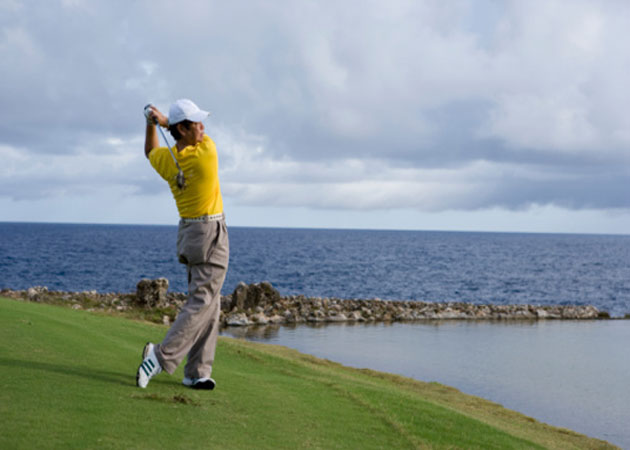The Sporting Life: Age-Friendly Fitness

How to enjoy these go-south sports at home and abroad without the injuries.
Golf, tennis and swimming may be popular activities among Canadians who spend their winter in warmer climates, but with all the indoor facilities and clubs available to us now, these sports can also be enjoyed year-round, in any weather. At this stage of life, how to have fun while avoiding injuries and setbacks is the main consideration.
If you’re heading abroad, take this advice: “I see too many people who, excited about escaping the cold weather, go crazy with sports during the first week at their warmer destination, resulting in injuries serious enough to interfere with the rest of their time down south,” says Dr. Stacy Irvine, chiropractor and co-owner of Totum Life Science in Toronto (www.totum.ca).
With these simple, sport-specific guidelines, you can enjoy your active holiday without care. If you have any concerns, consult your health-care professional before starting anything new. Game on!
NEXT: THE SWING OF GOLF
THE SWING OF GOLF
Golf is the least physically challenging of these three activities and isn’t considered cardiovascular because it doesn’t elevate your heart rate as swimming and playing tennis do. What it lacks in intensity, however, it makes up for in endurance. A typical golf game takes four hours to complete, so the calories burned and muscle endurance developed are very beneficial — especially if you skip the golf cart and walk the course! But there are still some risks.
“The golf swing can be a great flexibility exercise, but due to its ballistic nature, it does leave the body prone to injury if not warmed up or if general flexibility is lacking,” cautions Dr. Derek Porter, an Olympic rower and chiropractor at Vancouver’s West Fourth Chiropractic. He recommends you swing the club easily with some practice swings, and be sure to stretch hip flexors, hamstrings and trunk rotators prior to hitting the first tee.
Rx for Maximum Play
• Prior to stretching, be sure to warm up tight muscles with light cardio exercise (walk, bike, jog).
• If you are an avid golfer, Irvine suggests working with a trainer in your local gym to develop a personalized program tailored specifically to golf and to address your flexibility and strength. “This will improve your golf game and, at the same time, provide you with enormous health benefits that will last a lifetime.”
• Walking up and down hills and carrying your golf bag ups the intensity.
• As with any outdoor sport, stay hydrated, and wear sunscreen, light colours and a hat.
NEXT: TENNIS – ON THE BALL
TENNIS: ON THE BALL
Tennis is good, all-round exercise emphasizing the anaerobic system (start and stop and short bursts of activity). It will enhance your cardiovascular fitness, improve your bone density, balance and hand-eye co-ordination, and strengthen your legs, upper body and core muscles if you are playing at a fairly intense level.
Of all three activities, tennis can cause the most injuries. It can be tough on joints, particularly the knees, shoulders and elbows. “Among older people who play tennis, I see a lot of injuries because their joints, ligaments and tendons just don’t work the same, and a lot of weekend warriors hurt themselves,” says Steve Roest, president and owner of Fitness Institute in Toronto (www.fitnessinstitute.com). “Rotator-cuff injuries can occur when you’re doing the overhand serve, and I’ve also seen a lot of hip and knee problems associated with the quick stops, starts and the change of direction.” If you haven’t played frequently, it’s crucial to start slowly, and if there is discomfort, seek the help of a therapist before major problems develop.
Rx for Maximum Play
• Warm-up options include light stretching, riding a bike or brisk walking/running for five minutes; rally the ball before starting a game.
• To reduce the amount of wear and tear, doubles tennis is a great option and more social.
• When playing outdoors, be sure you are protected: wear sunscreen, light colours and a hat.
• Drink water to stay hydrated and cool and to avoid heat exhaustion.
NEXT: DIVE INTO SWIMMING
DIVE INTO SWIMMING
Swimming is an excellent non-impact cardiovascular activity that works both the upper and lower body.
“It’s fantastic for people with higher blood pressure,” adds Irvine. “The fact that you are horizontal while swimming means your blood pressure is actually lower while you participate in the activity. For anyone with slightly elevated blood pressure and/or joint problems, swimming is a fantastic choice.”
According to Roest, it’s just a matter of different strokes for different folks. “Swimming is excellent therapy for people with injuries because you can float and walk holding the sides of the pool. If you have any shoulder problems, stay away from the front crawl and choose strokes that won’t hurt them. For a weaker swimmer, the back crawl or side stroke is sometimes easier because your head is out of the water and you can breathe easier.”
For a challenge, Roest suggests trying to swim faster, go further and longer, or both. One day, try swimming faster for 20 minutes; the next, swim longer and slower for an hour.
Rx for Maximum Play
• Don’t eat an hour before you go swimming.
• Warm up by walking a bit in the shallow end, and do light stretches.
• Don’t go swimming in a pool or the ocean by yourself. It’s always better to have a partner.
• Swim in safe areas away from currents and strong tides that can pull you out into the deep.
• Wear a waterproof sunscreen.
• Drink water to avoid dehydration and feeling out of control. You may not realize that you are sweating.